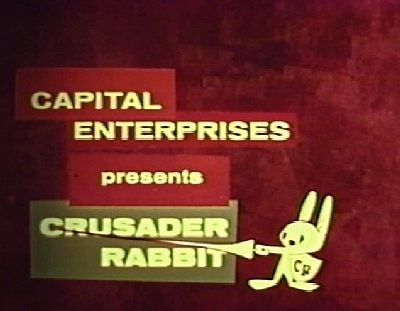Jay Ward, a close friend of Anderson's from their college days at the University of California, Berkeley, was a successful real estate agent. In May, 1948 he was approached by Anderson in an attempt to get financial backing for his project. Ward loved the idea and the two formed Television Arts Productions, with Ward as the business manager/producer. They rented an office at 111 Sutter Street in San Francisco for several months, eventually moving their studio into a garage-apartment behind Anderson's mother's house at 2733 Stewart in Berkeley, California.
Anderson's conception of their TV cartoons was of a comic strip with some movement. The TV industry was in it's infancy, and budgets were minimal. To keep costs down, Anderson developed techniques which simplified the movements. His feeling was that if a story was good enough it wouldn't need full animation to keep the attention of the audience.
Ward's involvement soon went beyond his role as business manager. He was an active participant in the development of the series. The name of the
CRUSADER RABBIT series came from Ward's concept of the rabbit as "a sort of crusading Don Quixote". He was consulted whenever needed, giving not only guidance, but taking charge of the sound production, doing some writing and acting as script editor.
In late 1948, Television Arts Productions had three proposals which they submitted to NBC-TV. They included
CRUSADER RABBIT , DUDLEY DO-RIGHT and HAMHOCK JONES. The proposed DUDLEY DO-RIGHT was basically the same as the one which Jay Ward later turned into a successful animated TV series.
HAMHOCK JONES was a series about Jones, a private eye, and a villain who was Siamese twins. One twin was good, the other evil. In the proposal story, a judge had to decide how to sentence the evil twin without locking up the good one. The
CRUSADER RABBIT pilot was about Crusader and Rags journey to Texas where hunters were making life miserable for the Texas jack rabbits.
NBC rejected Dudley and Hamhock, but gave the go-ahead to
CRUSADER RABBIT. Since Television Arts Productions was a new company, without any track record, NBC felt they needed corporate supervision. They appointed Jerry Fairbanks, their film buyer, to the post of supervising producer. Fairbanks had been a theatrical shorts producer and had produced Paramount Pictures popular
SPEAKING OF ANIMALS series.
In 1950 the studio moved from Berkeley to Los Angeles. NBC wanted to expand production to five episodes a week, and the Berkeley studio had only the space to do four. The increased production also required additional workers and Los Angeles had a better labor pool to draw from. Around this same time, a dispute arose over who owned the rights to the series. Jerry Fairbanks Productions had gone bankrupt and NBC foreclosed on their holdings. Shull Bonsell had purchased the rights to CRUSADER RABBIT from NBC, but Television Arts Productions argued in court that the rights belonged to them, not NBC or Jerry Fairbanks Productions. To settle the dispute, Shull Bonsell bought Television Arts Productions from Anderson and Ward. My original source stated that Jay Ward was allowed to retain the rights to the characters, but I received a message from Scott A. Anderson, the son of Alex Anderson and great nephew of Paul Terry, correcting this. Mr. Anderson wrote:
Mr. Anderson's full message can be viewed in the Toon Tracker Guestbook Archive.
Included in the rights retained by Anderson and Ward were characters developed for their unsold pilots, DUDLEY DO-RIGHT, and
THE FROSTBITE FALLS REVIEW with early versions of Rocky and Bullwinkle (see preliminary sketch below ) .
CLICK HERE FOR A SECOND PAGE OF CRUSADER RABBIT PICTURES !
After the sale production stopped and the staff disbanded. Anderson went into advertising and Ward went back to selling real estate. As soon as Ward made enough money selling real estate, he formed Jay Ward Productions and went on to produce cereal commercials for General Mills and Quaker (Captain Crunch, Quisp and Quake) and numerous TV series including BULLWINKLE, DUDLEY DO-RIGHT, ROCKY AND HIS FRIENDS, FRACTURED FLICKERS, HOPPITY HOOPER, and GEORGE OF THE JUNGLE. In 1957, Shull Bonsell's TV Spots/Capitol Enterprises contracted with Creston Studios to animate 260 color episodes of CRUSADER RABBIT for TV syndication. The episodes could be shown in 20 part serialized form, or as complete hour-long adventures.

In the 1970's, Metromedia acquired all rights to
CRUSADER RABBIT for their group of independent TV stations, and syndicated the
260 color episodes to other stations. In 1985, Rupert Murdoch's News Corporation had purchased Twentieth Century Fox and was looking for a way to get into the television network business. Metromedia, in the meantime, decided to put their TV holdings up for sale so they could concentrate on cellular communications. Murdoch needed a TV station group to give his new network exposure in the major markets. With stations in New York, Los Angeles and Chicago, the Metromedia group was just what Murdoch was looking for and the FOX network was born. As part of the Metromedia purchase, FOX acquired the rights to
CRUSADER RABBIT.
Check out the CRUSADER RABBIT PICTURE PAGE
with pictures from the original 1949 series and the 1957 remake.
Check out a second page of CRUSADER RABBIT PICTURES
View The Current Toon Tracker Guestbook
View The Toon Tracker Guestbook Archive
Send comments to: webmaster@toontracker.com
TOON TRACKER © 1996 - 2001
SINCE DECEMBER 15, 1996